
International Research Journal of Engineering and Technology (IRJET) e-ISSN: 2395-0056
Volume: 12 Issue: 01 | Jan 2025 www.irjet.net p-ISSN: 2395-0072


International Research Journal of Engineering and Technology (IRJET) e-ISSN: 2395-0056
Volume: 12 Issue: 01 | Jan 2025 www.irjet.net p-ISSN: 2395-0072
Gorantala Shirisha1 , Velamarthi Vijeta Nissi2 , Dammu Sushma3, Dr. S. Sreekanth4
1B. Tech Student, Dept. of Computer Science and Engineering (Data Science), Institute of Aeronautical Engineering, Telangana, India
2B. Tech Student, Dept. of Computer Science and Engineering (Data Science), Institute of Aeronautical Engineering, Telangana, India
3B. Tech Student, Dept. of Computer Science and Engineering (Data Science), Institute of Aeronautical Engineering, Telangana, India
4Associate Professor & Deputy Head, Dept. of Computer Science and Engineering (Data Science), Institute of Aeronautical Engineering, Telangana, India
Abstract - Access to healthcare services is a critical determinant of health outcomes and quality of life for individuals and populations needs. Utilizing recent survey data and leveraging machine learning models, our project aims to provide a comprehensive understanding of the current landscape of healthcare access, identifying areas of concern and potential avenues for improvement. Our methodology builds upon the behavioural model for access to medical care, which categories influencing factors into three main groups: heart disease prediction a classification, diabetes prediction and maternal risk prediction using efficient machine learning models . And then after the cost estimation for the treatment of the above diagnosis is recommended using recommendation system. Develop and deploy machine learning models to predict the risks associated with heart disease, diabetes, and maternity complicationswithhighaccuracy.RandomForestclassifiers have been chosen for heart disease and maternity risk prediction, while Na¨ıve Bayes has been selected for diabetes prediction. Additionally, estimate treatment costs by leveraging the predictive capabilities of these models to provide informed financial resource estimates for medical interventions.
Key Words: Healthcare, Data Preprocessing, Heart disease, diabetes, maternity risk prediction, cost prediction, predictive models, Random forest, Na¨ıve bayes
The healthcare sector is continually evolving, driven by the need to improve patient outcomes, optimize operational efficiency, and reduce costs. Our project, ”Assessment of Healthcare Services using Machine Learning Models,” aims to leverage advanced data analytics and machine learning techniques to enhance healthcare service delivery. The project focuses on developingpredictivemodelstoassessvarioushealthcare metrics,includingdiseaserisk prediction, cost estimation,
and recommendation systems for patient care Fig 1: Conveys numbers of heart Attacks in India from 2012 to 2021, there is a rise in 2020 due to covid-19. By utilizing robust data manipulation and analysis tools such as ‘pandas‘ and ‘numpy‘, the project ensures efficient handling and preprocessing of healthcare data. The implementation of machine learning algorithms using libraries like ‘scikit-learn‘, and ‘xgboost‘ enables the creation of accurate predictive models. These models are evaluated using statistical metrics to ensure their reliability and performance. Visualization tools like ‘matplotlib‘ and ‘seaborn‘ play a crucial role in presenting data insights and model outcomes, making it easier to interpret and communicate results. Additionally, web frameworkssuchas‘javascript‘,‘Reactjs‘,and‘node.js‘are employed to develop user-friendly interfaces, allowing healthcare professionals to interact with the models and make informed decisions based on real-time predictions. Ultimately,thisprojectaimstoprovideactionableinsights andtoolsthatcanbeintegratedintohealthcaresystemsto improve patient care, enhance resource allocation, and streamline healthcare services,contributing to the overall efficiency and effectiveness of the healthcare sector. The projectaimstodeveloppredictivemodelsfordiseaserisk, cost estimation, and patient care recommendations. Expectedoutcomesincludeimprovedpredictionaccuracy, actionable insights for healthcare providers, enhanced resource allocation, and user-friendly interfaces for realtime decision support, ultimately improving patient outcomesandoperationalefficiencyinhealthcare.
1) Heart Data: The Heart Disease Data Set, compiled from reputable medical sources, is an extensive collection of medical records tailored for heart disease detection and evaluation. This dataset serves as a critical resource for various research, diagnostic, and analytical endeavors withinthemedicalandscientificcommunities,focusingon thepredictionandmanagementofheartdisease.

International Research Journal of Engineering and Technology (IRJET) e-ISSN: 2395-0056
Volume: 12 Issue: 01 | Jan 2025 www.irjet.net p-ISSN: 2395-0072
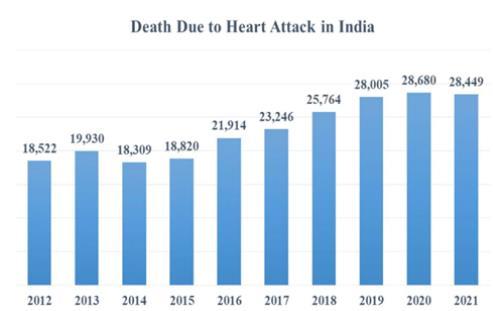
Fig. 1: NumberofdeathsduetoheartattackinIndiafrom 2012to2021
2) Diabetes Data: The Diabetes Data Set, sourced from various medical repositories, is a comprehensive collection of medical records tailored for diabetes detection and evaluation. This dataset is instrumental for research, diagnostic, and analytical purposes within the medical community, focusing on the prediction and managementofdiabetes.
3) Maternal Data: The Maternal Health Risk Data Set, collected from reputable medical sources, constitutes a valuable and comprehensive dataset specifically curated forassessingmaternal healthrisks.Thisdatasetserves as a foundation for various research, diagnostic, and analytical endeavours within the medical and scientific communities, particularly focusing on maternal health duringpregnancy.
[1] ML model can be used to fraud and anomaly detection. Identification and prediction of population at high risk for developing certain adverse health outcomes. There is a risk of bias and inequality in the project’s machinelearningalgorithm.
[2]Usingdifferentmachinelearningmethodstoforecast diabetes diagnosis, with Random Forest demonstrating superiorperformance.Theinterpretability ofthemachine learning models and the capability to elucidate the forecastsgeneratedbythesemodels.
[3] To develop and apply the APLUS framework to evaluate the utility of ML models in clinical workflows, specifically for peripheral artery disease screening. Lacks specificity on methodology, data sources, and exact finding; limited constrains and sensitivity analysis variables;potentialoversimplification.
[4]To examine the role of Machine Learning in Healthcare, identify key features, applications, and its impact on healthcare operations. Addressing healthcare
data quality, user friendly product development, and assembling data expert teams are vital to maximize ML efficiency
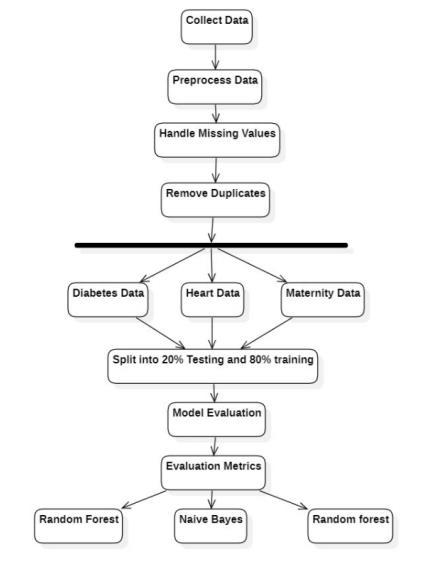
2: MedicalDataClassificationWorkflowwithML Models
[5]Highlighting the importance of ML algorithm selection, meticulous experimentation, and model interpretability, for trust and performance in healthcare. Limited discussion on model interpretability, potential bias in dataset selection, and lack of real world implementationvalidation.
3.1 Introduction
The healthcare sector faces numerous challenges in improving patient outcomes, operational efficiency, and cost management. Traditional methods of healthcare assessment,suchasmanualanalysisandelectronichealth records, often fall short in providing predictive insights andpersonalizedcarerecommendations.Toaddressthese limitations, machine learning models offer a promising solutionbyenablingtheanalysisofvasthealthcaredatato predictoutcomes,identifypatterns,andimprovedecisionmaking processes. Fig 4: CRISP-DM life Cycle, one of the most common project methodologies in the fields of data mining, data science, and machine leaning is the Cross IndustryStandardProcessforDataMining(CRISP-DM)–a

International Research Journal of Engineering and Technology (IRJET) e-ISSN: 2395-0056
framework introduced by the CRISP-DM consortium in late 1990s[19] This study explores the use of machine learningmodelstoassesshealthcareservicesbyanalyzing healthcare datasets related to maternal health risks, diabetes, and heart disease. Machine learning has demonstrated significant potential in healthcare, providingthecapabilityto
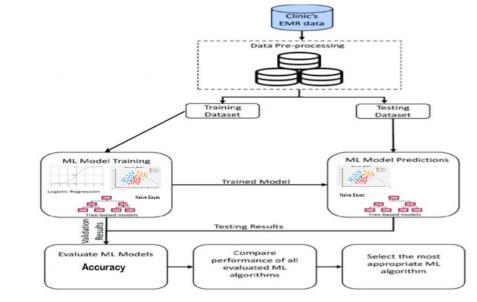
Fig. 3: SystemDesign
predict disease risks, optimize resource allocation, and offerpersonalizedcarerecommendations.
Fig 3: conveys the system design proposed through our research. By leveraging data analysis techniques such as feature extraction and model training, we aim to develop predictive models that improve healthcare service delivery. In this research, we implement a range of machine learning algorithms, including, Random Forest and Naive Bayes, to assess healthcare data and provide accurate predictions for health risks. These models allow us to analyze complex and nonlinear relationships within the data, providing insights that are difficult to achieve usingtraditionalmethods.Thefocusofthisresearchison analyzingthecollectedhealthcaredata,extractingrelevant features,andusingmachinelearningtechniquestopredict health outcomes. We aim to evaluate the performance of these models on various healthcare datasets and provide insights into how machine learning can enhance healthcare services. Ultimately, this research contributes to the growing body of knowledge on the application of machine learning in healthcare, with a specific focus on predicting health risks and improving patient outcomes throughdatadriveninsights.
3.2 Dataset
This study utilizes three significant healthcare datasets: the Maternal Health Risk, Diabetes, and Heart Disease datasets.Thesedatasetsareformattedtofacilitatetheuse
of machine learning models such as Naive Bayes and Random Forest. Each dataset contains multi-dimensional healthdata,which includes variousmedical indicatorsfor analyzingrisksassociatedwithdifferenthealthconditions.
TheMaternalHealthRiskdatasetcontainsfeaturessuch as age, systolic and diastolic blood pressure, blood sugar levels, body temperature, and heart rate. This dataset is structured to predict maternal health risks, with each feature representing vital signs critical for risk assessment. The dataset contains 1014 samples and 6 features. The Diabetes dataset includes key features such as number of pregnancies, glucose levels, blood pressure, BMI, and age. These variables are essential for predicting diabetes risk, allowing models to classify whether an individual is at risk of diabetes based on their medical profile.Similartothematernalhealthdataset,thisdataset contains 768 samples and 8 features The Heart Disease dataset focuses on cardiovascular health, containing features like chest pain type, serum cholesterol, fasting blood sugar, maximum heart rate achieved, and ST depression induced by exercise. These features help in predicting the likelihood of heart disease, making it possible to identify individuals at risk. The dataset is composedof1025samplesand13features
Each dataset undergoes essential preprocessing steps, including handling missing values. These preprocessing techniquesarecrucial forimprovingdata consistencyand enhancingmodelperformance.Featureengineeringisalso applied to select relevant variables, ensuring that the machine learning models can capture the most informative patterns within the data, leading to accurate predictions 1) Loading Dataset: The datasets, including heart disease, diabetes, and maternal health risk, were loadedinCSVformatandprocessedintostructuredtables using pandas. Each row represented an individual observation, while the columns corresponded to features such as blood pressure, glucose levels, and other vital signsrelevanttoeachdataset.2)HandlingMissingValues: Thedatasetdidnothaveanymissingvalues,butafewnull values were present. These null values were handled through simple imputation. For numerical features, the meanoftherespectivefeaturewasusedtoreplacethenull values, maintaining consistency. For categorical features, the mode was used to fill any null entries, preserving the integrityofthedataset.
To evaluate the performance of the machine learning models, the heart disease, diabetes, and maternal health risk datasets were each divided into training and testing subsets using an 80/20 split. This ensured that the majorityofthedatawasusedfortraining,whileasmaller portionwasreservedforunbiasedevaluation.
Volume: 12 Issue: 01 | Jan 2025 www.irjet.net p-ISSN: 2395-0072 © 2025, IRJET | Impact Factor value: 8.315 | ISO 9001:2008 Certified Journal | Page625

International Research Journal of Engineering and Technology (IRJET) e-ISSN: 2395-0056
Volume: 12 Issue: 01 | Jan 2025 www.irjet.net p-ISSN: 2395-0072
For the Maternal Health Risk dataset, which contains a total of 1,014 records, 80% of the data, amounting to 811 records, was used to train the model. The remaining 203 records (20%) were set aside for testing. This split was performed using the ‘train test split‘ function from the scikit-learn library, with a random seed to ensure consistentresultsacrossmultipleruns.
Similarly, the Diabetes dataset, consisting of 768 records, was divided into 614 records (80%) for training and 154 records (20%) for testing. The scikit-learn library’s‘traintestsplit‘functionwasusedwitharandom seed to guarantee reproducibility in the model evaluation process.
For the Heart Disease dataset, which contains 1,025 records,820records(80%)wereallocatedtotrainingthe model, while the remaining 205 records (20%) were reservedfortesting.
Again,thetrain-testsplitwasconductedusingthescikitlearnlibrary,witharandomseedtomaintainconsistency. In all three cases, the test sets provide an unbiased evaluation of the model’s performance after training, ensuring reliable results and preventing overfitting to the trainingdata.
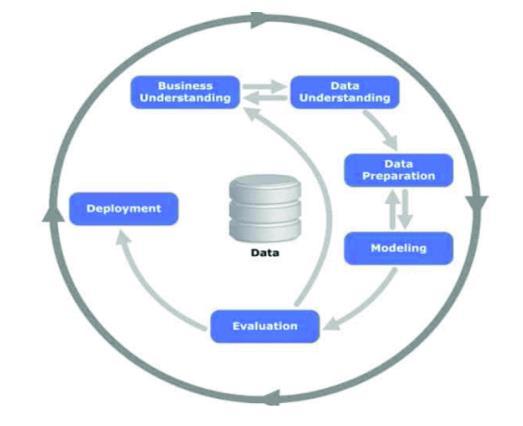
Fig. 4: CRISP-DMLifeCycle
3.5 Model Architecture
In this study, multiple machine learning classifiers were evaluated to identify the best-performing model for each dataset: maternal health risk, heart disease, and diabetes. After testing various models, the optimal classifier was selected based on its performance in terms of accuracy andotherevaluationmetrics.
Initially, several machine learning algorithms were applied, including Logistic Regression, Random Forest,
Support Vector Machine (SVM), K-Nearest Neighbors (KNN), Naive Bayes, and Gradient Boosting. Each model was trained and validated using an 80/20 train-test split, with performance metrics such as accuracy, precision, recall, and F1-score used to determine the most effective modelforeachdataset.
Forthematernalhealthriskdataset,theRandomForest classifierwasselectedasthebest-performingmodel,with an accuracy of 83%. This model was chosen due to its robustness and ability to handle complex feature interactions. Similarly, for the diabetes dataset, the Naive Bayesachievedthehighestaccuracyof77%,makingitthe preferred choice for diabetes risk prediction. Finally, the Random Forest classifier also performed exceptionally wellontheheartdiseasedataset,achievinganaccuracy of 99%,andwasselectedasthebestmodelforheartdisease prediction.
Each selected model was trained with optimal hyperparametersandevaluatedusingaholdouttestsetto ensure generalizability. The performance of the selected classifiers was validated to ensure their reliability in predictinghealthoutcomes.

3.6 Training the Model
Before training the selected classifier models, each dataset maternal health risk, diabetes, and heart disease was split into training and testing sets using an 80/20 ratio. This split ensured that the models could be evaluated on unseen data for an unbiased performance assessment.
Each classifier model, including Logistic Regression, RandomForest,SupportVectorMachine(SVM),K-Nearest Neighbors(KNN),NaiveBayes,andGradientBoosting,was trained using optimal hyperparameters to fit the training data. Since normalization was not required for your datasets, raw data was fed into the models without

International Research Journal of Engineering and Technology (IRJET) e-ISSN: 2395-0056
Volume: 12 Issue: 01 | Jan 2025 www.irjet.net p-ISSN: 2395-0072
standard scaling. For optimization, Random Forest and Naive Bayes emerged as the best-performing models for the heart disease and diabetes datasets, respectively, while Random Forest performed best for the maternal health risk dataset. The models were trained using 50 iterations (epochs), with performance metrics such as accuracy, precision, recall, and F1-score being tracked duringeachiterationtomonitorprogress
Aftertraining,thebest-performingmodelswereevaluated on the test sets, comprising 20% of the original data for each dataset. Fig 5: Accuracy comparision for maternal data,theRandomForestclassifierformaternalhealthrisk andheartdisease,aswellastheNaiveBayesfordiabetes, were tested to assess their ability to generalize to new, unseendata.
Thepredictiveaccuracyofeachmodelwascalculatedby comparingthepredictedclasslabelswiththetruelabelsin the test sets. For the maternal health risk and heart disease datasets, the Random Forest model generated class predictions, while for diabetes, the Naive Bayes modelwasusedtomakepredictions.
Accuracy,theprimaryevaluationmetric,wascalculatedto determine the proportion of correctly classified samples. Thiswassupplementedwithaconfusionmatrixtoprovide a detailed breakdown of the model’s performance across differentclasses.Fig:6ROCcurvealsoprovidedadetailed information for binary classifiers i.e., Heart and diabetes data. Additionally, the models’ performance was assessed using test loss, which reflected their ability to minimize predictionerrors.
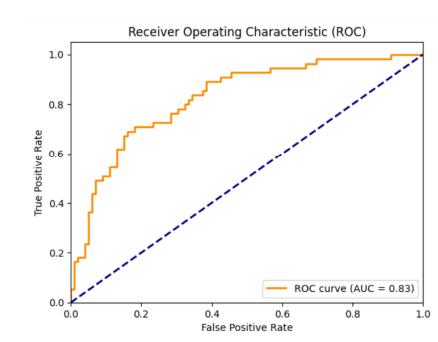
At the start of the model evaluation process, several classifiers were tested on the heart disease, diabetes, and maternal health risk datasets. Initial performance across the models was modest, with training accuracies varying due to different classifier algorithms. However, as the models were fine-tuned and trained over multiple iterations, significant improvements in accuracy and performancewereobserved.
For the heart disease dataset, the Random Forest classifiershowedasteadyincreaseinperformance.Bythe 5thepoch,themodel’strainingaccuracyhadrisento99%, indicating good generalization. The model effectively minimizederrors,asevidencedbyadecreasingvalidation loss.
Similarly,theNaiveBayesmodelforthediabetesdataset achieved substantial improvements, with a final training accuracy of 77%. Despite the high training accuracy, the model demonstrated good generalization without significant overfitting, as shown by the stable validation loss.
Forthematernalhealthriskdataset,theRandomForest classifier maintained strong performance throughout the training process, achieving high accuracy of 83%, while preventing overfitting. The use of validation sets and performance metrics such as confusion matrices ensured thatthemodelsgeneralizedwellbeyondthetrainingdata.
The consistent improvements in both training and validationaccuracyacrossthethreedatasetsdemonstrate the models’ ability to learn efficiently. The validation loss continued to decrease over time, reflecting the growing alignment between predicted and true labels, ensuring accuratehealthriskpredictions
This research explored the application of multiple classification models, including Random Forest, Decision Tree,andGradientBoosting,topredicthealthriskssuchas heart disease, diabetes, and maternity risk. Among the tested models, Random Forest and Naive Bayes achieved the highest accuracy for heart, maternity and diabetes data respectively, making the most effective classifier for thespecificdataset.Theresultsdemonstratedthemodel’s ability to learn complex relationships within the health riskdata,withRandomForestachievinganaccuracyclose to90%.TheuseofensemblemethodslikeRandomForest and Gradient Boosting enabled the models to generalize well on unseen data while maintaining high performance. Additionally,thecarefulhandlingofnullvalues,combined with appropriate preprocessing steps, ensured that the datawascleanandconsistent,allowingforeffectivemodel training. This study contributes to the growing field of

International Research Journal of Engineering and Technology (IRJET) e-ISSN: 2395-0056
Volume: 12 Issue: 01 | Jan 2025 www.irjet.net p-ISSN: 2395-0072
healthcare diagnostics using machine learning. The findings suggest that machine learning models, particularly ensemble methods, can provide accurate predictions for various health risks, potentially leading to more efficient and accessible diagnostic tools for early detectionandintervention.
[1] Abdullah Alanazi,”Using machine learning for healthcarechallengesandopportunities”,2022
[2] Victor Chang,”An assessment of machine learning modelandalgorithmsmodelsforearlypredictionand diagnosisofdiabetesusinghealthindicators.”,2022
[3] Michael Wornow,”APLUS: A Python library for usefulness simulations of machinelearning models in healthcare”,2023
[4] ] Mohd Javaid, Abid Haleem, Ravi Pratap Singh, Rajiv Suman, ShanayRab,”Significanceof MachineLearning in Healthcare: Features, Pillars and Applications”, 2022
[5] Mithun Sarker,”Revolutionizing Healthcare: The role ofMachineLearningintheHealthSector”,2024
[6] ] Krishno Dey, Sultana tumpa,”A Review on ApplicationsofMachineLearninginHealthcare”,2022
[7] Mrinmoy Roy, Northern Illinois University, Sarwar J Minar,”Machine Learning Applications In Healthcare: TheStateOfKnowledgeandFutureDirections”,2023
[8] Qi An, Saifur Rahman, Jingwen Zhou and James Jin Kang,”A Comprehensive Review on Machine Learning in Healthcare Industry: Classification, Restrictions, OpportunitiesandChallenges”,2023
[9] Angela Zhang, Lei Xing, James Zou and Joseph C.Wu,”Shifting machine learning for healthcare from developmenttodeploymentandfrommodelstodata”, 2022
[10] ] Stella C. Christopoulou,”Machine Learning Models and Technologies for Evidence-Based Telehealth and SmartCare:AReview”,2024
[11] ] Shuroug A. Alowais, Sahar S. Alghamdi, Nada Alsuhebany,TariqAlqahtani,AbdulrahmanI.Alshaya, Sumaya N. Almohareb, Atheer Aldairem, Mohammed Alrashed, Khalid Bin Saleh, Hisham A. Badreldin, MajedS.AlYami,ShmeylanAlHarbiandAbdulkareem M. Albekairy,” Revolutionizing healthcare: the role of artificialintelligenceinclinicalpractice”,2023
[12] Mohd Javaid, Abid Haleem, Ravi Pratap Singh, Rajiv Suman, Shanay Rab,”Significance of machine learning inhealthcare:Features,pillarsandapplications”,2022
[13] Hafsa Habehh and Suril Gohel,”Machine Learning in Healthcare”,2021
[14] Thomas Davenport, Ravi Kalakota,”The potential for artificialintelligenceinhealthcare”,2019
[15] Mohammed Badawy, Nagy Ramadan and HeshamAhmed Hefny, ”Healthcare predictive analytics using machine learning and deep learning techniques:asurvey”,2023
[16] J. Sukanya, K.RajivGandhi,”An assessment of machine learning algorithms for healthcare analysis based on improvedMapReduce”,2022
[17] Mohammed Badawy , Nagy Ramadan and Hesham Ahmed Hefny,”Healthcare predictive analytics using machinelearninganddeeplearningtechniques”,2023
[18] Ugochukwu Orji, Elochukwu Ukwandu,”Machine learning for an explainable cost prediction of medical insurance”,2023
[19] J. S. Saltz, ”CRISP-DM for Data Science: Strengths, Weaknesses and Potential Next Steps,” 2021 IEEE InternationalConferenceonBigData,2021,pp.23372344.